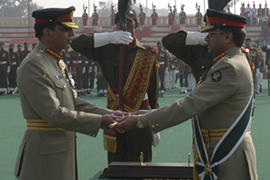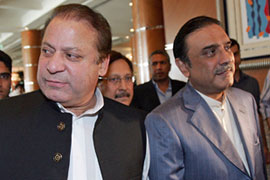Analysis: Musharraf fights on
As pressures for his dismissal increase, the president holds out for US support.

 |
| Newspaper reports said Musharraf, right, and Kayani met to discuss the president’s options in case of renewed efforts to force his resignation [EPA] |
In 2002, Pervez Musharraf, the current Pakistani president, promised to retire and play golf after handing over power to an elected prime minister.
Six years down the road, and after presiding over four prime ministers, he has yet to produce signs of a golf club or a tennis racket in hand.
In a meeting with television journalists on Saturday, Musharraf asserted that he had no intention to resign or go into exile.
But at the same time, the retired general also noted that he does not see a role for himself if he was confined to “an inconsequential (function)”.
Currently, Musharraf is in the eye of a storm with nearly all power stakeholders at home arraigned against him. Even his allies are conspicuous by their silence.
However, the US — a major player in the Pakistani power matrix — is an exception. George Bush, the US president, called Musharraf last week in a desperate attempt to salvage his oldest ally in the war on terror, and delivered a message purportedly aimed at the very stakeholders trying to force his ouster.
“The president reiterated the United States’ strong support for Pakistan and indicated he looked forward to President Musharraf’s continuing role in further strengthening US-Pakistani relations,” White House spokeswoman Dana Perino told reporters.
In an unusual move, the White House then broke with tradition to give details of the phone conversation.
Midnight missive
 |
| Musharraf, right, passes the baton of command over to General Ashfaq Kayani in 2007 [REUTERS] |
The US damage-control move followed a recent report in the daily The News which divulged a three-and-a-half hour meeting between the beleaguered president and army chief Ashfaq Kayani.
The meeting itself came against the backdrop of a change in command of the Triple-One Brigade — an elite force of the army commonly known as the “coup brigade” for its role in military takeovers — and the redeployment of troops at the presidential premises.
The replacement of Brigadier Asim Bajwa, who headed the Triple-One Brigade, is seen as a major departure from Musharraf’s legacy. Bajwa was considered a staunch Musharraf loyalist and received special mention from the president in his autobiography In The Line of Fire.
The reported redeployment of troops as part of an elaborate security cover for Musharraf at the presidential premises has fueled speculation that he is finally leaving the Army House, a domicile traditionally reserved for the army chief.
It is believed that Musharraf wanted to stay on in the well-equipped Army House for security reasons but more likely to give the impression he still held the army in sway.
This has not gone down well with Pakistani political commentators who have bitterly criticised the president for violating procedure by continuing to occupy the house since he gave up the position of army chief last November.
The Kayani-Musharraf midnight meeting plunged by more than 500 points the Karachi Stock Exchange, which is usually seen as a barometer of how the business community views the situation.
The spokespersons of both the Presidency and army dispelled the impression that the meeting was anything other than “routine” and the army described the Brigade change as one “in the works for months”.
War-gaming?
Shafqat Mehmood Qureshi, a former member of parliament and columnist thinks the Brigade change will be a key instrument with which to tackle Musharraf.
He said: “I think Musharraf called Kayani because he wanted to assess his options and find out that in case the coalition parties decide to impeach him, he could rely on [the] army’s support.”
Kayani’s response is not difficult to decipher, Qureshi believes. “He must have asked the president to leave the army out of politics and not enforce any steps against democratic norms.”
In the last few days, rumours were afloat that Musharraf might use his constitutional powers to dismiss the parliament, if pushed to the wall.
Reaching crescendo
 |
| Reports say Zardari, right, and Sharif, have agreed on how to remove Musharraf [REUTERS] |
Calls for Musharraf to resign have reached a crescendo with both Asif Ali Zardari, the leader of the Pakistan People’s Party (PPP), and Nawaz Sharif, the former prime minister, attacking the president.
In a recent interview with the Press Trust of India, Zardari called Musharraf “a relic of the past” before asserting that his party – the PPP – did not consider the president “a legal, constitutional president”.
Sources privy to the co-operation between Zardari and Sharif claim that they have a tacit understanding on how to deal with the Musharraf imbroglio.
As part of this unspoken deal, the PML-N’s open salvos are tempered by the PPP’s ambiguous statements of keeping a working relationship with the president — only for it to launch another warning about impeachment.
The idea, these sources say, is to pressure Musharraf into resigning because Zardari does not wish to annoy the Bush administration by impeaching him just yet.
The PPP leader is beholden to the administration for facilitating his party’s return to power courtesy a series of give-and-take steps with Musharraf.
Meanwhile, Musharraf has reportedly, told his confidantes that he has made up his mind to quit if impeachment proceedings are initiated. Until then, he intends to fight all attempts to use the Ctrl-Alt-Del button on him.
The writer is news editor at Dawn News, an independent Pakistani TV channel.
The views expressed by the author are not necessarily those of Al Jazeera.